1296 and 432 MHz EME with 2.4m/3m/3.15m dish
I started thinking about 1296 EME in the summer of 2017. I see a lot of spurious signals in the 432 MHz region including multiple birdies and periodic noise bursts that don't prevent EME operation but can make things difficult and prevent reception of weaker signals at times, depending on the direction in which the antenna is pointing.
One way to get away from man made noise (and some natural noise) is to move up in frequency and 1296 MHZ is the obvious choice here. It's reasonably easy to assemble a 1296 MHz capable EME station. A preamp noise figure under 0.3dB isn't hard to achieve and solid state power at the 150W level is fairly easy. 150W amplifiers can be combined for 300W or 600W if more power is desired. The ideal antenna is a dish and a small dish of around 2.4m (8ft) combined with 150W will give a signal that is capable of working a lot of stations using digital (WSJT) modes. It should also be capable of detecting it's own echos using WSJT, and of copying the ON0EME beacon's signal off the moon at a signal strength (on a good day) that will allow the CW portion of the transmission to be copied by ear. Activity on 1296 is also relatively high. Not as high as on 144 MHz, but higher than on 432 MHz or any other band except for 144 MHz.
As of December 2017 I have a 2.4m dish operational with automatic moon tracking with 0.2 degree accuracy, a 2.6dB HF preamp (G4DDK) and an OK1DFC design septum feed for 1296. I also have an OK1DFC design loop feed for 432. I'm receiving signals well on both bands. A 2.4m dish is very small for 432 EME, but I'm hearing quite well and expect to be able to make quite a few contacts using my 600W tube amplifier. As of February 2018 I am QRV on 432 but RX only 1296.
Here are some pictures of the new 1296 and 432 dish system:
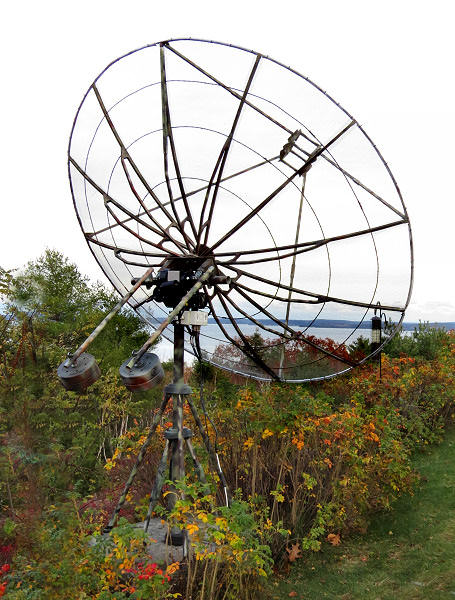
The 2.4m dish. The tripod is bolted into a large granite boulder which weighs a could of tons.
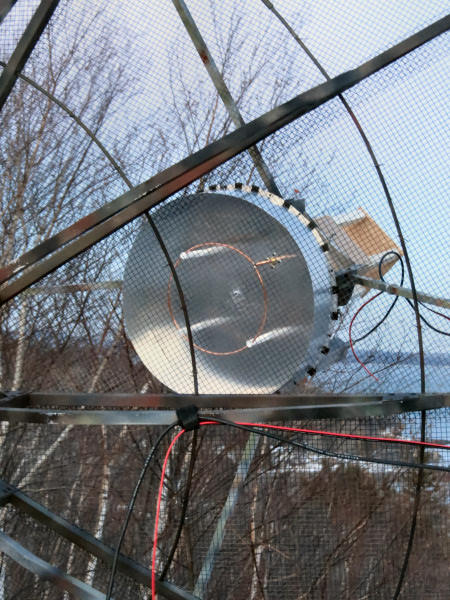
The 432 loop feed in place
The loop feed is rotated using a stepper motor. It can rotate through 180 degrees in a few seconds. Here's a short video clip of a bench test of the polarization rotation of the 432 Feed
Here's a shot of the dish setup for 1296 operation:
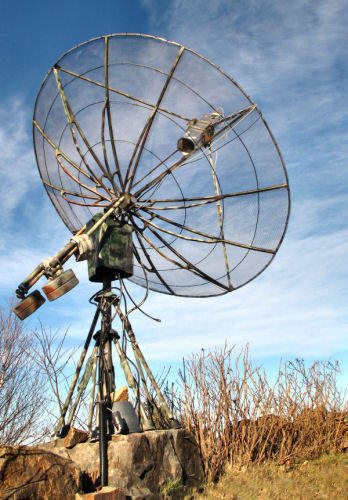
Timetable for EME operation
I'm currently (04/18) QRV on 432 EME with around 500W (350W at feed) and I've made a number of EME QSOs including NC1I, HB9Q, VK4EME (who was running 200W at the time), JA6AHB and KF8MY. Polarization rotation is working and I can detect my own echoes at around -24dB (2500Hz BW). So the 432 system is definitely operational, but not yet optimized. I expect to do about 1dB better when I have all the cables cut to the correct length and the T/R changover system properly configured.
On 1296 I'm currently (04/18) QRV with around 50-75W at the feed. I've made around 15 QSO's so far, including some relatively small stations (e.e. 3m dish and 40w, 2x47el Yagi and 400W)
Currently (4/18) most of my attention is focused on 1296 operation.
My 432 EME operation went QRT in 2018. I no longer have the 500W PA amd I no longer have the Yagis I previously used. In theory I might be able to make some 432 contacts using the 3m dish and the 80W or so I still have, but I have not operated on 432 EME since 2018 and I currently have no plans to operate gain on 432MHz. I am QRV on 23cm and have a 1.2m dish for 10Ghz (Rx only).
Status - December 2018
Currently (December 2018) I have expanded the dish to 3m and increased 1296 power to around 240W at the feed if I have the amplifier out at the base of the dish, and about 150W if I have the amplifier indoors. Unless there is some sort of special need for the extra power (which is typically not the case for most JT65C operation on 1296) the amplifier will stay indoors over the winder, so it doesn't get buried in snow and ice! It can be moved outdoors if needed.
I'm not currently operating on 432 since it's such a pain to switch over both the feed and the wiring in the shack (not to mention high local QRM and noise floor on 432 plus the limited capabilities of a 3m dish). However I do intend to try to make the changeover in the shack easier by adding some additional switching rather than having to reconfigure all the cables by hand. When working I probably have 300-400W at the (rotatable) feed. When the weather warms up I may be more inclined to change the dish feed to 432 on occasion!
In the 9 months between April 2018 and December 2018 I've made around 115 initial contacts on 1296 (including WAC if I had the cards!). Probably about 1/2 of those were made with the 2.4m dish and maybe 70W at the feed.
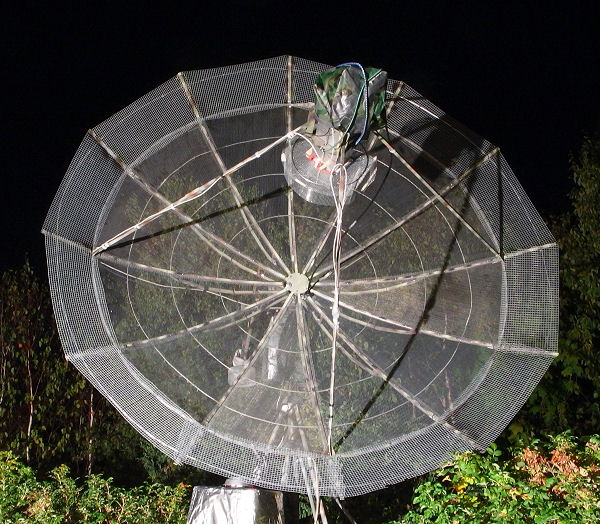
Dish with 432 feed installed!)
Status - June 2019
The dish has been expanded slightly on 10 of its 12 segments. The overall shape is a truncated dodecahedron. It now has the approximate area of a round 3.15m dish and an f/d ratio around 0.33. The feed has been modified to include a new square to round flare and a mesh frame choke (see Septum flare feed) The dish is very likely under-illuminated with respect to obtaining maximum gain. Sun noise is around 11.6dB for the quiet sun (10.7cm flux ~67, 23cm flux ~50), comparing the sun at high elevation (~ 60 degrees) and the quietest part of the sky (usually pointing approximately north and at an elevation around 60 degrees). The preamp is a G4DDK with a NF probably the region of 0.25-0.3dB. There's a Transco SMA SPDT isolation relay between the preamp and the RX port of the feed which probably adds at least 0.05dB loss.
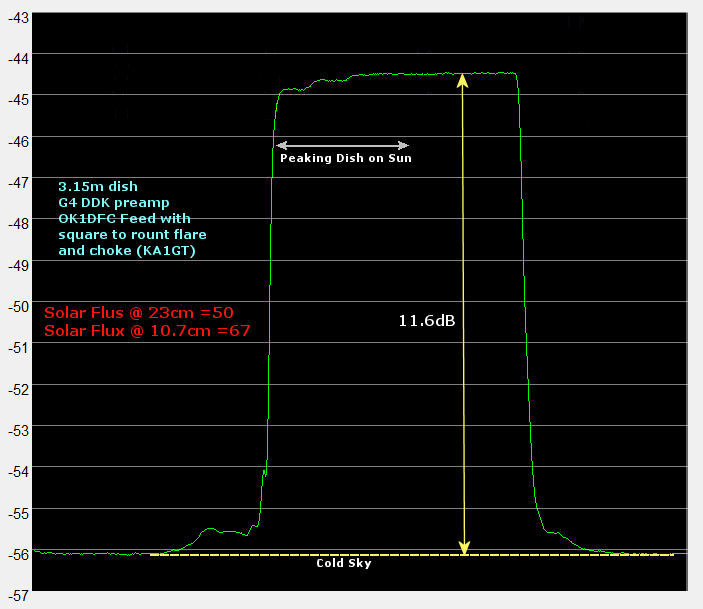
With more recent feed and system modification (see 2020 updates) I now see around 13dB of sun noise (quiet sun). On a very cold day (-10C) I have seen 13.1dB with the quiet sum (SFU ~ 68 at 10.7cm)
The pictures of the dish below were taken on 6/22/2019. The grey housing contains the 300W power amplifier which delivers around 240W at the feed.
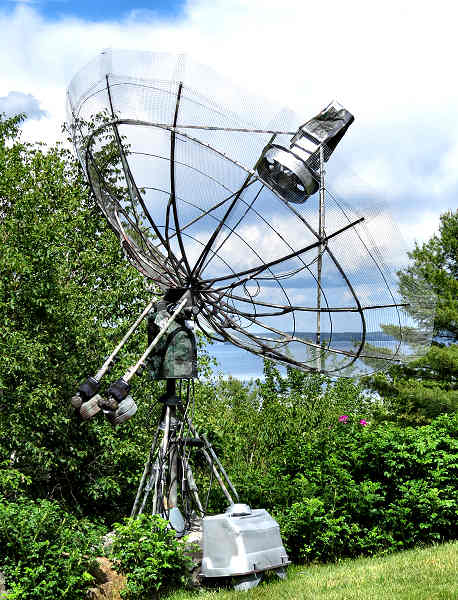
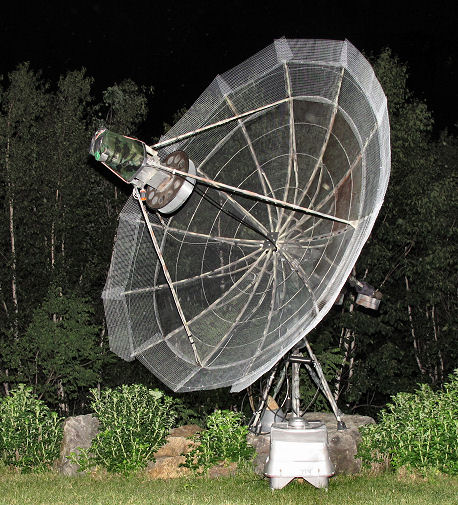
QSL Policy
I don't send QSL cards for every new contacts, but I do return cards received. Return postage is not required. I upload all QSOs (eventually...) to LOTW. Sometimes I may be several months behind on LOTW updates.
.jpg)